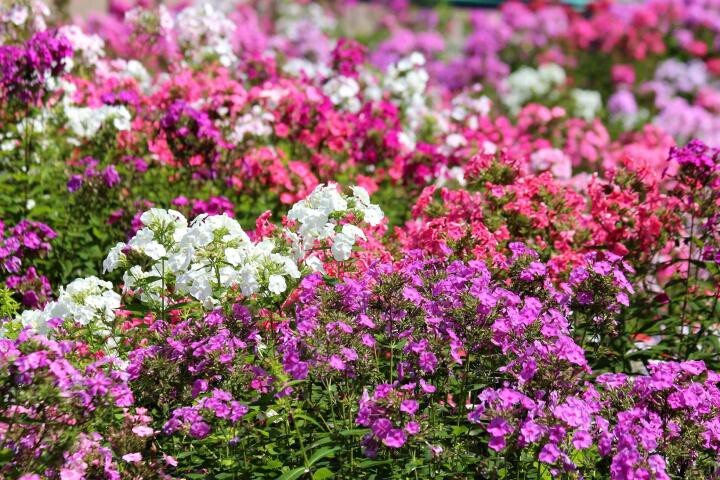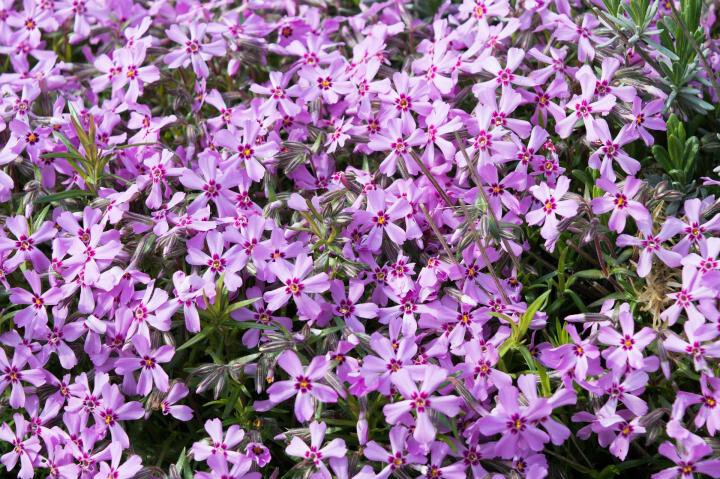Phlox are perennials and a favorite choice—from ground cover blooming in early spring to the tall phlox blooming in mid- to late summer. Learn more about how to grow and care for your phlox.
These plants sport many star-shaped, colorful flowers when in bloom. Because there are so many varieties and types (many of which are native to North America), you can find a phlox for almost any garden. Truly, their versatility can’t be overstated.
Low-growing phlox work great as a ground cover.
Tall phlox are excellent as a colorful backdrop.
Medium-height varieties can fill in any gaps.
Plus, they’re low maintenance and have a lovely fragrance.
PLANTING
Use a garden fork or tiller to prepare your garden bed. Loosen the soil to about 12 to 15 inches deep, then mix in a 2- to 4-inch layer of compost.
It is easier to grow phlox from cuttings/transplants than from seeds.
Plant phlox in the spring—after the threat of frost has passed—and space the plants 1 to 2 feet apart. If you are moving a plant from a pot, dig a hole about twice the size of the pot’s diameter and place the plant so that the top of the root ball is even with the soil’s surface. Fill in around the root ball and remember to water it thoroughly.
In general, phlox need a planting site with rich, evenly-moist, well-draining soil, but lighting requirements vary by species.

CARE
If you receive less than 1 inch of rain a week, remember to regularly water your plants throughout the summer.
Each spring, put a thin layer of compost and a 2-inch layer of mulch around the plants to help keep the soil moist and control weeds.
Remember to remove the dead/faded flowers so that your plants can rebloom.
If you have tall phlox, cut the stems back to about 1 to 2 inches above the soil after the first killing frost in the fall. (See local frost dates.) Divide tall garden phlox every 2 to 3 years to ensure healthy and disease-free plants.
PESTS/DISEASES
Powdery mildew is common; keep proper air circulation in mind when spacing out plants and avoid getting excess water on the foliage. Cutting back stems after flowering can also help to reduce the spread of powdery mildew, as can choosing mildew-resistant varieties.
Stem canker
Rust
Southern blight
Stem nematodes
Leaf spots
Leaf miners
Caterpillars
RECOMMENDED VARIETIES
You just can’t go wrong with phlox! Here are some of the best species and varieties to try:
LOW-GROWING PHLOX
Creeping phlox or Moss phlox (Phlox subulata) is a low-growing species that works excellently as a ground cover. It spreads slowly, growing in mounds that get 4–6 inches thick. The whole plant turns into a carpet of color in spring, when flowers cover every square inch of foliage. This phlox is particularly stunning when allowed to drape over a rock wall—imagine a waterfall of color! Creeping phlox grows best in well-drained soil and partial to full sun.
‘Candy Stripe’ is a popular variety with pink-and-white–striped flowers.
‘Emerald Blue’ produces a sea of lilac-blue flowers (perfect for that waterfall of color!).

Phlox stolonifera, which also goes by the common names Creeping phlox and Moss phlox, is similar to P. subulata in name only. The main differences between it and P. subulata are that its leaves are oval-shaped (rather than needle-shaped) and its flowers are produced on stems that rise 6–10 inches above the foliage (rather than directly on the foliage). It prefers a shadier growing site with rich, evenly-moist soil.
‘Sherwood Purple’ is a delicate little phlox with purplish-pink flowers.
Woodland phlox or Blue phlox (Phlox divaricata) is another low-growing species. As its two common names suggest, it prefers partial to full shade and moist, rich soils, and produces bluish flowers in early spring. Like P. stolonifera, its flowers bloom on stems that rise about a foot or so above the creeping foliage.
‘Chattahoochee’ and ‘Blue Moon’ are two great varieties with beautiful blue-to-violet flowers.
MEDIUM-HEIGHT PHLOX
Annual phlox or Drummond’s phlox (Phlox drummondii) grows as an annual rather than a perennial, unlike most other phlox species. Annual phlox rarely grows taller than 2 feet in height. Most varieties are not very heat tolerant, but in warmer regions you may find the heat-tolerant varieties for sale. Plant in well-draining soil in a site that gets partial sun and doesn’t stay too wet.
TALL PHLOX
Garden phlox or Summer phlox (Phlox paniculata) is the tallest phlox in cultivation and is probably the species that most folks have in their gardens. It grows in clumps that reach between 3 and 5 feet in height and produces panicles of flowers in mid- to late summer. Though tolerant of most lighting, it grows and flowers best in partial to full sun. It has a reputation for being very susceptible to powdery mildew, but resistant varieties are available.
‘David’ has bright white flowers and is resistant to powdery mildew.
‘Jeana’, another mildew-resistant variety, produces panicles of petite purplish flowers—similar in appearance to a butterfly bush.
OTHER PHLOX
The phlox listed above are just a few of the many species out there. Others of interest to gardeners may be Carolina phlox (P. carolina), Meadow or Spotted phlox (P. maculata), and Sand phlox (P. bifida).
WIT & WISDOM
April’s full Moon has traditionally been called the “Full Pink Moon” because it heralded the appearance of the “moss pink,” or wild ground phlox—one of the first spring flowers.